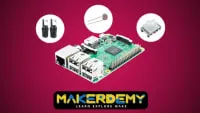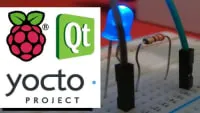
Hardware projects using Raspberry Pi 
This guide provides step-by-step instructions on how to use the Raspberry Pi's GPIO pins to create hardware projects and interact with the physical world. With this knowledge, users can explore the possibilities of the Raspberry Pi. ▼
ADVERTISEMENT
Course Feature
![]() Cost:
Cost:
Free
![]() Provider:
Provider:
Udemy
![]() Certificate:
Certificate:
No Information
![]() Language:
Language:
English
Course Overview
❗The content presented here is sourced directly from Udemy platform. For comprehensive course details, including enrollment information, simply click on the 'Go to class' link on our website.
Updated in [March 06th, 2023]
This course provides an introduction to hardware projects using Raspberry Pi. Students will learn how to create a Raspberry Pi based Walky Talky, build a light detector mechanism, and build a motion detector using a PIR motion sensor. The course will also provide step by step code to build the project.
The course will begin with an introduction to Raspberry Pi and its components. Students will learn about the different types of Raspberry Pi boards, the different types of Raspberry Pi operating systems, and the different types of Raspberry Pi accessories.
Next, students will learn how to create a Raspberry Pi based Walky Talky. They will learn how to connect the Raspberry Pi to a radio module, how to program the radio module, and how to use the radio module to communicate with other Walky Talky users.
Following this, students will learn how to build a light detector mechanism. They will learn how to connect the Raspberry Pi to a light sensor, how to program the light sensor, and how to use the light sensor to detect light levels.
Finally, students will learn how to build a motion detector using a PIR motion sensor. They will learn how to connect the Raspberry Pi to the PIR motion sensor, how to program the PIR motion sensor, and how to use the PIR motion sensor to detect motion.
At the end of the course, students will have a complete understanding of how to create hardware projects using Raspberry Pi. They will be able to create their own projects and use the Raspberry Pi to create a variety of projects.
[Applications]
The application of this course can be seen in various hardware projects. Students can use the knowledge gained from this course to create a Raspberry Pi based Walky Talky, build a light detector mechanism, and build a motion detector using a PIR motion sensor. Additionally, the course provides step by step code to build the project, which can be used to create a variety of hardware projects.
[Career Paths]
1. Robotics Engineer: Robotics Engineers design, develop, and test robots for a variety of applications. They use Raspberry Pi to create robots that can be used in a variety of industries, such as manufacturing, healthcare, and agriculture. With the increasing demand for automation, the demand for Robotics Engineers is expected to grow significantly in the coming years.
2. IoT Developer: IoT Developers use Raspberry Pi to create Internet of Things (IoT) applications. They develop applications that can be used to control and monitor devices remotely. With the increasing demand for connected devices, the demand for IoT Developers is expected to grow significantly in the coming years.
3. Embedded Systems Engineer: Embedded Systems Engineers use Raspberry Pi to create embedded systems. They develop systems that can be used in a variety of industries, such as automotive, aerospace, and medical. With the increasing demand for embedded systems, the demand for Embedded Systems Engineers is expected to grow significantly in the coming years.
4. AI Developer: AI Developers use Raspberry Pi to create Artificial Intelligence (AI) applications. They develop applications that can be used to automate tasks and make decisions. With the increasing demand for AI applications, the demand for AI Developers is expected to grow significantly in the coming years.
[Education Paths]
1. Computer Science Degree: A computer science degree is a great way to learn the fundamentals of programming and hardware engineering. With this degree, you can learn how to design, develop, and maintain computer systems and networks. You can also learn how to develop software applications and hardware projects using Raspberry Pi. Additionally, you can learn about the latest trends in computer science, such as artificial intelligence, machine learning, and cloud computing.
2. Electrical Engineering Degree: An electrical engineering degree is a great way to learn the fundamentals of electrical engineering and hardware engineering. With this degree, you can learn how to design, develop, and maintain electrical systems and networks. You can also learn how to develop hardware projects using Raspberry Pi. Additionally, you can learn about the latest trends in electrical engineering, such as robotics, automation, and renewable energy.
3. Robotics Degree: A robotics degree is a great way to learn the fundamentals of robotics and hardware engineering. With this degree, you can learn how to design, develop, and maintain robotic systems and networks. You can also learn how to develop hardware projects using Raspberry Pi. Additionally, you can learn about the latest trends in robotics, such as artificial intelligence, machine learning, and autonomous vehicles.
4. Internet of Things (IoT) Degree: An IoT degree is a great way to learn the fundamentals of IoT and hardware engineering. With this degree, you can learn how to design, develop, and maintain IoT systems and networks. You can also learn how to develop hardware projects using Raspberry Pi. Additionally, you can learn about the latest trends in IoT, such as artificial intelligence, machine learning, and cloud computing.
Course Syllabus
Introduction and Hardware Requirements
Concept behind FM frequency
Attaching Antenna to Raspberry Pi
Linux command to transmit voice
Linux Command to emit audio frequency
Transmit your voice at particular frequency
Live testing of Walky Talky Project
Pros & Cons

Very good course

Learned something new in every lesson

Great introductory course

Fun

No instructions on setting up development environment

No breadboard used

Watching program get typed in is slow

Projects don't have much realworld applications
Course Provider

Provider Udemy's Stats at AZClass
Discussion and Reviews
0.0 (Based on 0 reviews)
Explore Similar Online Courses

Artificial Intelligence for Civil Engineers: Part 1

Wi-Fi Ethical Hacking and Security

Python for Informatics: Exploring Information

Social Network Analysis

Introduction to Systematic Review and Meta-Analysis

The Analytics Edge

DCO042 - Python For Informatics

Causal Diagrams: Draw Your Assumptions Before Your Conclusions

Whole genome sequencing of bacterial genomes - tools and applications

Powering your Home Projects with Raspberry Pi

Creative Audio Programming on the Raspberry Pi

Raspberry Pi with embedded Linux made
 Related Categories
Related Categories
 Popular Providers
Popular Providers
Quiz
 Submitted Sucessfully
Submitted Sucessfully
1. What is the main purpose of this course?
2. What is the main output of this course?
3. What is the main focus of this course?
4. What is a PIR motion sensor?
Correct Answer: It is a passive infrared sensor.


Start your review of Hardware projects using Raspberry Pi